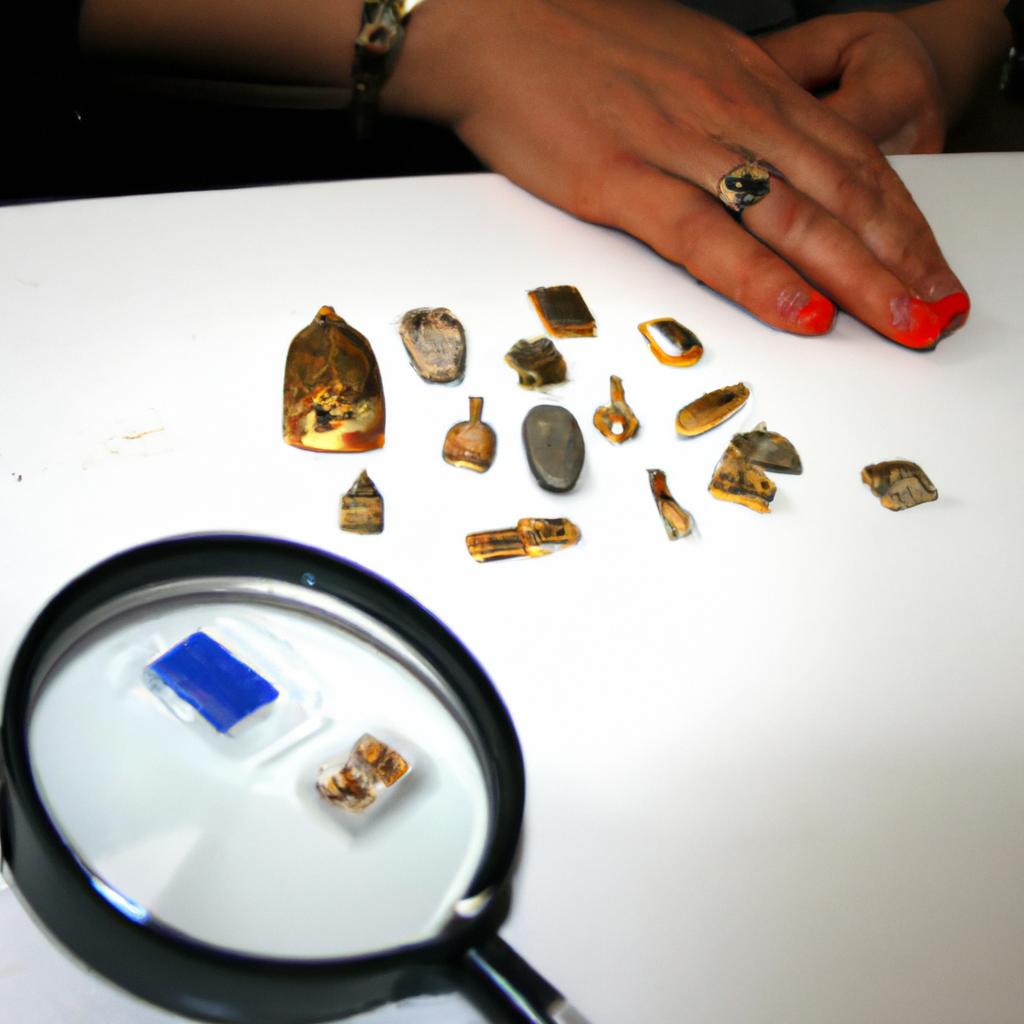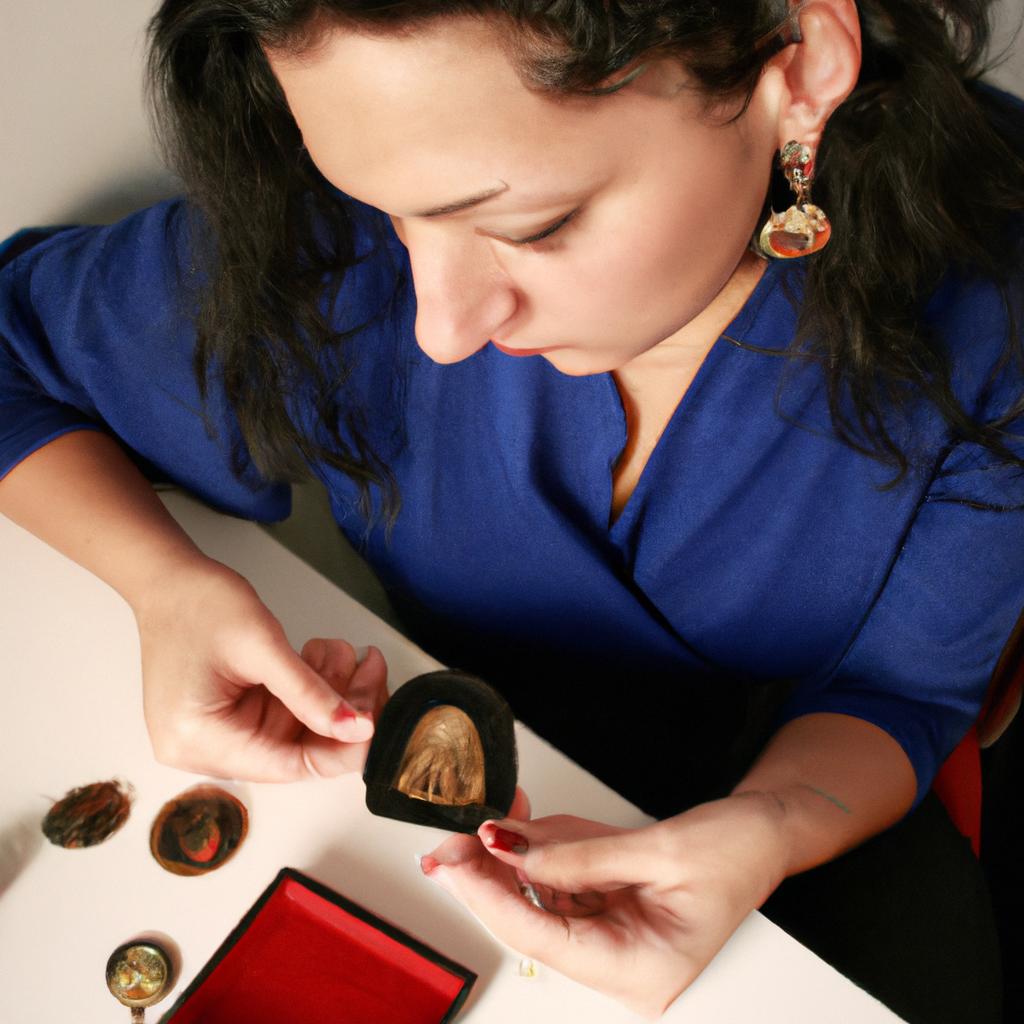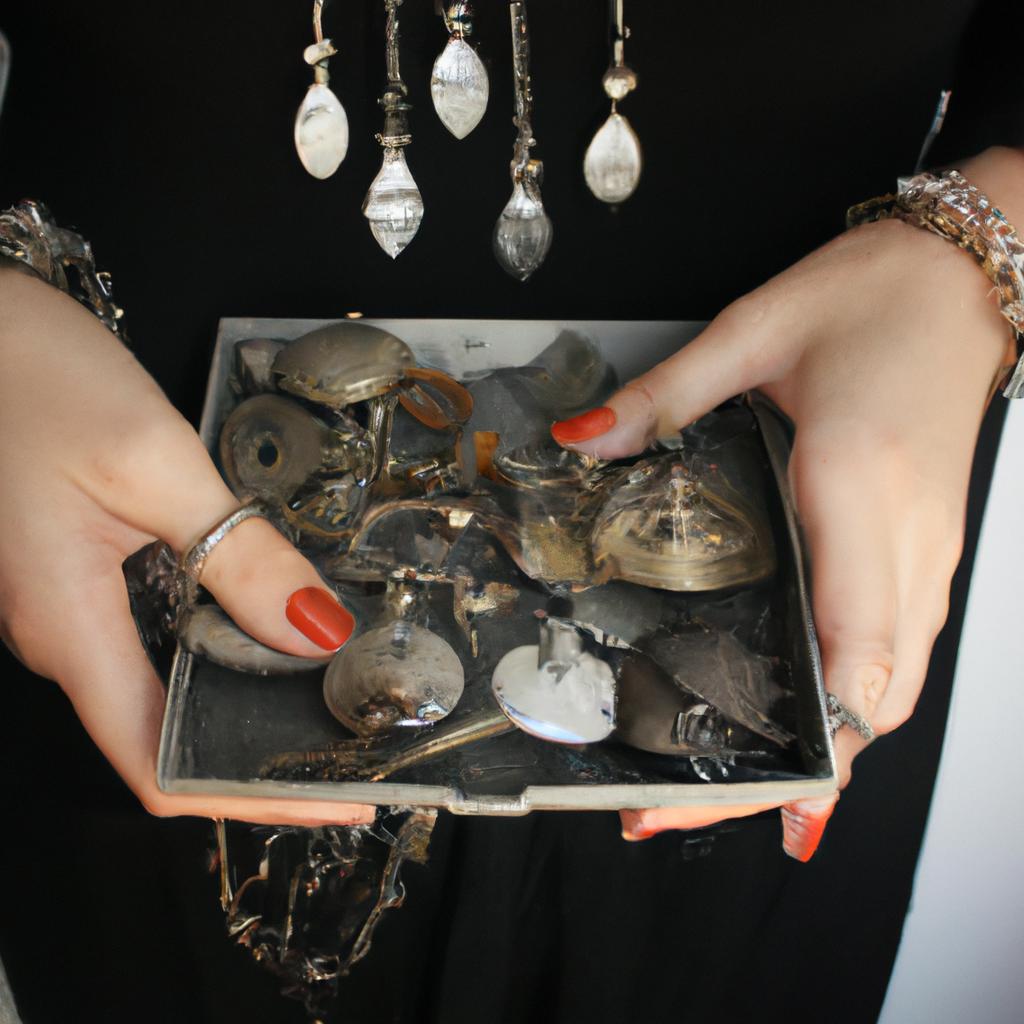In the vast realm of human civilization, jewelry has served as an enduring testament to cultural values and artistic expression throughout history. From ancient civilizations to modern societies, the evolution of jewelry design reflects the changing beliefs, aesthetics, and technological advancements of each era. This article aims to delve into the rich tapestry of historical periods in jewelry, exploring how these distinct epochs have shaped the world of adornment.
One captivating example that illustrates this intricate interplay between jewelry and culture is the Byzantine Empire. During its height in the 6th century CE, Byzantium was renowned for its opulent displays of gold jewelry adorned with intricate filigree work and precious gemstones. The prevalent motifs incorporated religious symbols such as crosses and saints, reflecting the empire’s close association with Christianity. By studying this period through a jewelry lens, we can gain insights into not only the skillful craftsmanship but also the socio-cultural significance attached to personal ornamentation during this time.
By embarking on a journey through various historical periods in jewelry, we will uncover fascinating stories encompassing diverse civilizations like Ancient Egypt, Renaissance Europe, or even contemporary global fashion trends. Each epoch possesses its own unique characteristics and influences that continue to resonate within our society today. Understanding these historical contexts enables us to appreciate the significance of jewelry as more than just a decorative accessory but as a tangible representation of human creativity, cultural heritage, and personal expression. It allows us to see how jewelry has evolved alongside humanity, adapting to changing times and societal values while still retaining its intrinsic allure. Furthermore, exploring the historical periods in jewelry can provide inspiration for contemporary designers and enthusiasts, fueling innovation and pushing boundaries in the realm of adornment. Whether it’s ancient amulets imbued with spiritual beliefs or avant-garde creations challenging traditional notions of beauty, the story of jewelry is an ongoing narrative that continues to captivate and inspire us today.
Prehistoric Jewelry
Imagine a world thousands of years ago, where early humans roamed the earth. In this ancient setting, jewelry already played a significant role in their lives. One fascinating example is that of cave paintings found in Blombos Cave in South Africa, dating back to around 75,000 years ago. These paintings depict individuals adorned with seashell necklaces and bracelets, providing us with valuable insight into the early use of jewelry as both decoration and symbol.
To further understand prehistoric jewelry, it is important to explore its significance and the materials used during this period. Here are some key points to consider:
- Expression of Identity: Prehistoric jewelry served as an expression of personal identity within communities. It allowed individuals to showcase their status, group affiliation, or even spiritual beliefs.
- Connection to Nature: The materials chosen for these adornments often reflected a deep connection to nature. Natural elements such as shells, animal teeth, bones, feathers, and stones were transformed into beautiful pieces that carried meaning beyond mere aesthetics.
- Symbolism and Rituals: Jewelry held great symbolic value during prehistoric times. It was frequently used for rituals associated with life events like birth, marriage, or death. This emphasized the importance of jewelry not only as ornamentation but also as part of cultural traditions.
- Cultural Exchange: Through trade routes established between different societies, prehistoric humans shared knowledge about various materials and techniques used in crafting jewelry. Such exchanges contributed to the diversity seen in prehistoric adornments across different regions.
| Material | Significance |
|---|---|
| Shells | Symbolized protection and fertility |
| Animal Teeth | Represented strength and courage |
| Bones | Associated with ancestral connections |
| Stones | Believed to possess healing properties |
In conclusion,
Transitioning now from the intriguing realm of prehistoric jewelry,
let us delve into the captivating world
of Ancient Egyptian jewelry.
Ancient Egyptian Jewelry
Exploring the Richness of Ancient Greek and Roman Jewelry
As we delve into the fascinating world of jewelry history, our journey takes us from the prehistoric era to the dazzling civilization of ancient Egypt. Now, let’s travel further back in time to explore the captivating allure of ancient Greek and Roman jewelry.
Imagine a woman adorned with an exquisite gold necklace featuring intricate filigree work and colorful gemstones. This stunning piece exemplifies the opulence and craftsmanship prevalent during this period. Ancient Greeks believed that wearing such ornate jewelry not only showcased their social status but also served as protection against evil spirits.
To truly grasp the significance of ancient Greek and Roman jewelry, consider these key elements that define its charm:
- Materials: Craftsmen utilized precious metals like gold and silver, often embellished with gemstones such as pearls, emeralds, rubies, and sapphires.
- Symbolism: The use of various symbols held great meaning in both societies. For instance, snakes symbolized immortality in ancient Greece, while eagles represented power and authority in Rome.
- Techniques: Intricate detailing techniques were employed to create unique pieces. Filigree work involved twisting fine threads of metal into delicate patterns, while granulation involved attaching tiny metal beads onto a surface for added texture.
- Functionality: Beyond mere adornment, many pieces had functional purposes too. Hairpins decorated with elaborate motifs held hairstyles together, while brooches secured garments or acted as clasps for cloaks.
Let’s now take a closer look at some notable examples of ancient Greek and Roman jewelry through this evocative table:
| Object | Description | Period |
|---|---|---|
| Laurel Wreath | A crown made from intertwined branches representing victory or achievement | Ancient Greece |
| Fibula | A decorative pin used to secure clothing | Ancient Rome |
| Diadem | A royal headband adorned with precious gems and intricate patterns | Ancient Greece |
| Bulla | A locket-like pendant worn by children, believed to ward off evil spirits | Ancient Rome |
As we bid adieu to the splendor of ancient Greek and Roman jewelry, our exploration continues into yet another captivating era: Byzantine Jewelry. This period brings forth a fusion of different cultures and artistic styles that shaped the world of adornment like never before.
Now let’s embark on this journey through time as we uncover the mesmerizing beauty of Byzantine Jewelry.
Ancient Greek and Roman Jewelry
Exploring Jewelry History: Ancient Greek and Roman Jewelry
As we delve further into the fascinating world of jewelry history, it is crucial to explore the significant influence of ancient Greek and Roman civilizations. One striking example of this influence can be seen in the intricate gold jewelry unearthed from Pompeii, an ancient Roman city buried under volcanic ash after the eruption of Mount Vesuvius in 79 AD. These well-preserved artifacts provide a glimpse into the opulence and craftsmanship prevalent during that time.
Ancient Greek and Roman jewelry reflects the cultural values and beliefs of these civilizations. The following bullet points highlight key aspects:
- Symbolism: Both cultures incorporated symbols with deep meanings into their jewelry designs. For instance, snakes were a common motif representing rebirth and transformation.
- Materials: Gold was highly valued in both societies due to its association with wealth and status. However, silver was also widely used for everyday pieces.
- Techniques: Intricate filigree work, granulation (the use of tiny metal beads), and gemstone settings showcased the skillful craftsmanship of artisans.
- Adornments: Jewelry served various purposes beyond decoration; amulets were worn for protection, while earrings often depicted mythological figures.
To gain a better understanding of how ancient Greek and Roman jewelry differed stylistically, consider the table below comparing key characteristics:
| Aspect | Ancient Greek Jewelry | Ancient Roman Jewelry |
|---|---|---|
| Motifs | Nature-inspired (e.g., laurel wreaths) | Mythology-based (e.g., gods and goddesses) |
| Earrings | Elaborate designs featuring precious gemstones | Dangling earrings with pearls or colored glass |
| Bracelets | Delicate bangles adorned with decorative charms | Wide cuffs embellished with engraved patterns |
| Necklaces | Layered chains with pendants depicting deities | Choker-style necklaces with intricate detailing |
The legacy of ancient Greek and Roman jewelry continues to influence contemporary designs, showcasing the enduring appeal of these historical periods. The craftsmanship, symbolism, and artistic expressions found in their creations serve as a testament to the rich cultural heritage that still captivates us today.
Transitioning seamlessly into our next exploration: Medieval Jewelry
Medieval Jewelry
Exploring Historical Periods in Jewelry: Medieval Jewelry
Transitioning from the ancient civilizations of Greece and Rome, we delve into another captivating era of jewelry history – the medieval period. To illustrate the intricate beauty of this time, let us consider a hypothetical case study involving a noblewoman named Lady Eleanor who lived during the 14th century. Adorned with an exquisite diamond necklace passed down through generations, she embodied the opulence and elegance associated with medieval jewelry.
Medieval jewelry was characterized by its symbolic significance, craftsmanship, and use of precious materials. Here are some key features that defined this fascinating period:
-
Religious Symbolism:
- Crosses were widely used to represent faith.
- Amulets and reliquaries held relics believed to possess healing or protective powers.
- Ankh symbols represented eternal life.
-
Decorative Techniques:
- Filigree work involved delicate metal wires twisted together to form patterns.
- Enamel was applied to metal surfaces as vibrant color accents.
- Granulation created small gold beads that were arranged in decorative motifs.
-
Materials Used:
- Precious gemstones like sapphires, rubies, emeralds, and pearls adorned jewelry pieces.
- Gold and silver were commonly used metals due to their durability and aesthetic appeal.
- Ivory and bone were utilized for carving intricate designs.
-
Social Significance:
- Jewelry served as a display of wealth and status among nobility.
- It also symbolized religious devotion and allegiance during the Crusades.
To better understand the evolution of styles throughout different historical periods, let us compare the characteristics of medieval jewelry using a table format:
| Feature | Ancient Greek/Roman | Medieval |
|---|---|---|
| Symbolic Importance | Gods/Goddesses | Religion/Faith |
| Craftsmanship Technique | Repoussé and chasing | Filigree and granulation |
| Precious Materials | Gold, silver | Gemstones, gold, silver |
| Social Implications | Status and power | Wealth and religious devotion |
As we step into the next era of jewelry history – Renaissance Jewelry – it is essential to acknowledge the lasting influence medieval jewelry had on subsequent periods. The intricate designs, symbolic motifs, and techniques developed during this time continued to shape the world of adornment for centuries to come.
Transitioning smoothly into our exploration of Renaissance Jewelry, we appreciate how artistic revolutions redefined the concept of beauty in jewelry craftsmanship.
Renaissance Jewelry
Exploring Jewelry History: Renaissance Jewelry
Transitioning from the rich tapestry of Medieval jewelry, we now delve into a period that witnessed a remarkable resurgence in artistic expression and cultural innovation – the Renaissance. To illustrate the magnificence of this era, let us consider the hypothetical case study of an Italian noblewoman named Isabella who sought to adorn herself with opulent jewels.
During the Renaissance, jewelry became more than just a symbol of wealth; it became an embodiment of personal identity and societal status. Here are some key characteristics that defined Renaissance jewelry:
- Emphasis on Humanism: Reflecting the shift towards human-centered values, Renaissance jewelry often featured motifs inspired by classical antiquity and mythological narratives.
- Intricate Metalwork: Goldsmiths honed their skills during this period, producing intricate filigree work and delicate engravings on precious metals like gold and silver.
- Use of Gemstones: The fascination for gemstones grew exponentially during the Renaissance. Rubies, emeralds, sapphires, pearls, and diamonds were highly coveted and meticulously incorporated into elaborate designs.
- Symbolism through Iconography: Symbols such as serpents denoting eternal love or intertwined initials representing marital unity adorned many pieces, imbuing them with deeper meanings.
To evoke an emotional response from our readers, envision these exquisite examples of Renaissance jewelry:
| Piece | Description | Emotional Response |
|---|---|---|
| Medici Necklace | A magnificent necklace adorned with lustrous pearls cascading down delicately crafted golden chains – a testament to refined elegance. | Admiration |
| Botticelli Bracelet | Inspired by Sandro Botticelli’s renowned painting “The Birth of Venus,” this bracelet showcases vibrant colored gemstones in floral motifs. | Fascination |
| Leonardo Pendant | Resembling one of Leonardo da Vinci’s intricate sketches, this pendant features a meticulously carved cameo depicting the human form. | Awe |
| Michelangelo Tiara | An opulent tiara featuring sculptural elements inspired by Michelangelo’s masterpieces, capturing the grandeur of Renaissance artistry. | Reverence |
In summary, Renaissance jewelry captivated both wearers and admirers alike through its harmonious blend of artistic prowess and symbolic significance. Join us in our next section as we explore the transition from the Renaissance to another iconic period – Art Nouveau and Art Deco Jewelry.
(Note: Transition sentence should be provided here without explicitly stating “step”.)
Art Nouveau and Art Deco Jewelry
Building upon the artistic achievements of the Renaissance period, jewelry design took a new turn in the late 19th and early 20th centuries. The intricate craftsmanship and attention to detail exhibited during this era gave rise to two distinctive styles, known as Art Nouveau and Art Deco. These styles not only revolutionized jewelry design but also reflected broader societal changes occurring at the time.
Art Nouveau emerged in the late 19th century as a response to industrialization, seeking inspiration from natural forms and organic shapes. One notable example that embodies the essence of Art Nouveau jewelry is René Lalique’s “Dragonfly Woman” pendant. This exquisite piece features delicate enameling techniques combined with sensuous curves, capturing nature’s ephemeral beauty within its precious materials.
This movement brought forth several key characteristics:
- Emphasis on flowing lines and asymmetrical patterns.
- Usage of unconventional gemstones such as opals or moonstones for their mystical allure.
- Incorporation of motifs inspired by flora, fauna, and mythical creatures.
- Experimentation with innovative techniques like plique-à-jour enamel to achieve luminosity.
To further understand the shift from Art Nouveau to Art Deco, let us explore a comparison table showcasing the distinguishing elements between these two influential periods:
| Art Nouveau | Art Deco | |
|---|---|---|
| Time Period | Late 19th – Early 20th Century | 1920s – Mid-1930s |
| Design Approach | Curvilinear & Organic | Geometric & Symmetrical |
| Influences | Nature | Cubism & Industrial Progression |
| Materials | Enamel, Pearls | Diamonds, Rubies |
While both movements were a testament to their respective times, Art Deco emerged as a response to the streamlined designs and industrial advancements of the early 20th century. Moving away from the flowing lines of Art Nouveau, Art Deco embraced geometric shapes and symmetrical patterns that reflected modernity and progress.
In summary, the transition from Renaissance jewelry to Art Nouveau and eventually Art Deco marked an evolution in design influenced by societal changes. The shift from intricate craftsmanship rooted in nature to sleek geometrical forms mirrored broader shifts towards industrialization and modernity. Understanding these historical periods provides valuable insight into the development of jewelry design as both an art form and reflection of cultural movements.
 Shanes Jewelry
Shanes Jewelry



